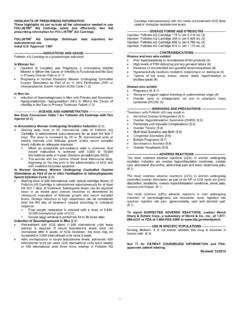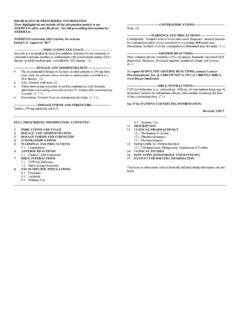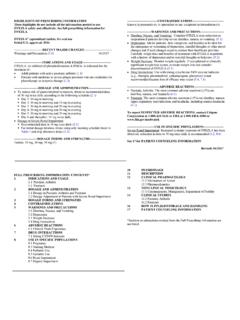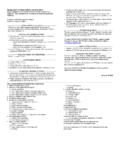Transcription of HIGHLIGHTS OF PRESCRIBING INFORMATION ... - LUNESTA
1 1 HIGHLIGHTS OF PRESCRIBING INFORMATION These HIGHLIGHTS do not include all the INFORMATION needed to use LUNESTA safely and effectively. See full PRESCRIBING INFORMATION for LUNESTA . LUNESTA (eszopiclone) tablets, for oral use, CIV Initial Approval: 2004 _____RECENT MAJOR CHANGES _____ Dosage and Administration (2) 5/2014 Warnings and Precautions (5) 5/2014 Studies Pertinent to Safety Concerns for Sedative 5/2014 Hypnotic Drugs ( ) _____ INDICATIONS AND USAGE _____ LUNESTA is indicated for the treatment of insomnia. LUNESTA has been shown to decrease sleep latency and improve sleep maintenance (1) _____ DOSAGE AND ADMINISTRATION _____ Use the lowest dose effective for the patient (2) Recommended initial dose is 1 mg, immediately before bedtime, with at least 7-8 hours remaining before the planned time of awakening.
2 May increase dose if clinically indicated, to a maximum of 3 mg ( ) Geriatric or debilitated patients: Dose should not exceed 2 mg ( ) Patients with severe hepatic impairment, or taking potent CYP3A4 inhibitors: Dose should not exceed 2 mg ( ) Do not take with or immediately after a meal ( ) _____ DOSAGE FORMS AND STRENGTHS _____ Tablets: 1 mg, 2 mg, and 3 mg (3) _____ CONTRAINDICATIONS _____ Known hypersensitivity to eszopiclone (4) _____ WARNINGS AND PRECAUTIONS _____ CNS depressant effects: Impaired alertness and motor coordination, including risk of morning impairment. Risk increases with dose. Caution patients taking 3 mg dose against driving and against activities requiring complete mental alertness during the morning after use.
3 ( ) Evaluate for Co-Morbid Diagnoses: Reevaluate if insomnia persists after 7 to 10 days of use ( ) Severe Anaphylactic/Anaphylactoid Reactions (angioedema and anaphylaxis have been reported): Do not rechallenge if such reactions occur ( ) Abnormal Thinking, Behavioral Changes ( , hallucinations), Complex Behaviors ( , sleep-driving ): Immediately evaluate if occurs ( ) Worsening of Depression or Suicidal Thinking may occur: Prescribe the least number of tablets feasible to avoid intentional overdose ( , ) Withdrawal Effects: symptoms may occur with rapid dose reduction or discontinuation ( , ) Elderly Patients: Use lower dose due to impaired motor, cognitive performance and increased sensitivity ( , ) Patients with hepatic impairment, impaired respiratory function, impaired drug metabolism or hemodynamic responses: Use with caution ( ) _____ ADVERSE REACTIONS _____ Most commonly observed adverse reactions (incidence 2%) were unpleasant taste, headache, somnolence, respiratory infection, dizziness, dry mouth, rash, anxiety, hallucinations, and viral infections ( ) To report SUSPECTED ADVERSE REACTIONS, contact Sunovion Pharmaceuticals Inc.
4 At 1-877-737-7226 or FDA at 1-800-FDA-1088 or _____ DRUG INTERACTIONS_____ CNS Depressants: Additive CNS-depressant effects with combination use. Use with ethanol causes additive psychomotor impairment ( ) Rifampicin: Combination use may decrease exposure and effects of LUNESTA ( ) Ketoconazole: Combination use increases exposure and effect of LUNESTA . Dose reduction of LUNESTA is needed ( ) _____ USE IN SPECIFIC POPULATIONS _____ Pregnancy: Based on animal data, may cause fetal harm ( ) Pediatric Use: Safety and effectiveness not established. Dizziness, dysgeusia, hallucinations, suicidal ideation reported ( ) See 17 for PATIENT COUNSELING INFORMATION and Medication Guide Revised: 05/2014 FULL PRESCRIBING INFORMATION .
5 CONTENTS* 1 INDICATIONS AND USAGE 2 DOSAGE AND ADMINISTRATION Dosage in Adults Geriatric or Debilitated Patients Patients with Severe Hepatic Impairment, or Taking Potent CYP3A4 Inhibitors Use with CNS Depressants Administration with Food 3 DOSAGE FORMS AND STRENGTHS 4 CONTRAINDICATIONS 5 WARNINGS AND PRECAUTIONS CNS Depressant Effects and Next-Day Impairment Need to Evaluate for Co-Morbid Diagnoses Severe Anaphylactic and Anaphylactoid Reactions Abnormal Thinking and Behavioral Changes Withdrawal Effects Timing of Drug Administration Special Populations 6 ADVERSE REACTIONS Clinical Trials Experience Post-Marketing Experience 7 DRUG INTERACTIONS CNS Active Drugs Drugs that Inhibit or Induce CYP3A4 8 USE IN SPECIFIC POPULATIONS Pregnancy Nursing Mothers Pediatric Use Geriatric Use Hepatic Impairment 9
6 DRUG ABUSE AND DEPENDENCE Controlled Substance Abuse Dependence Tolerance 10 OVERDOSAGE Signs and Symptoms Recommended Treatment 11 DESCRIPTION 12 CLINICAL PHARMACOLOGY Mechanism of action Pharmacokinetics 13 NONCLINICAL TOXICOLOGY Carcinogenesis, Mutagenesis, Impairment of Fertility 14 CLINICAL STUDIES Transient Insomnia Chronic Insomnia (Adults and Elderly) Studies Pertinent to Safety Concerns for Sedative Hypnotic Drugs 16 HOW SUPPLIED/STORAGE AND HANDLING 17 PATIENT COUNSELING INFORMATION *Sections or subsections omitted from the full PRESCRIBING INFORMATION are not listed. 2 _____ FULL PRESCRIBING INFORMATION 1 INDICATIONS AND USAGE LUNESTA (eszopiclone) is indicated for the treatment of insomnia.
7 In controlled outpatient and sleep laboratory studies, LUNESTA administered at bedtime decreased sleep latency and improved sleep maintenance. The clinical trials performed in support of efficacy were up to 6 months in duration. The final formal assessments of sleep latency and maintenance were performed at 4 weeks in the 6-week study (adults only), at the end of both 2-week studies (elderly only) and at the end of the 6-month study (adults only). 2 DOSAGE AND ADMINISTRATION Use the lowest effective dose for the patient. Dosage in Adults The recommended starting dose is 1 mg. Dosing can be raised to 2 mg or 3 mg if clinically indicated. In some patients, the higher morning blood levels of LUNESTA following use of the 2 mg or 3 mg dose increase the risk of next day impairment of driving and other activities that require full alertness [see Warnings and Precautions ( )].
8 The total dose of LUNESTA should not exceed 3 mg, once daily immediately before bedtime [see Warnings and Precautions ( )]. Geriatric or Debilitated Patients The total dose of LUNESTA should not exceed 2 mg in elderly or debilitated patients. Patients with Severe Hepatic Impairment, or Taking Potent CYP3A4 Inhibitors In patients with severe hepatic impairment, or in patients coadministered LUNESTA with potent CYP3A4 inhibitors, the total dose of LUNESTA should not exceed 2 mg [see Warning and Precautions ( )]. Use with CNS Depressants Dosage adjustments may be necessary when LUNESTA is combined with other CNS depressant drugs because of the potentially additive effects [see Warnings and Precautions ( )].
9 Administration with Food Taking LUNESTA with or immediately after a heavy, high-fat meal results in slower absorption and would be expected to reduce the effect of LUNESTA on sleep latency [see Clinical Pharmacology ( )]. 3 3 DOSAGE FORMS AND STRENGTHS LUNESTA is available in 1 mg, 2 mg and 3 mg strengths for oral administration. LUNESTA 3 mg tablets are round, dark blue, film-coated, and identified with debossed markings of S193 on one side. LUNESTA 2 mg tablets are round, white, film-coated, and identified with debossed markings of S191 on one side. LUNESTA 1 mg tablets are round, light blue, film-coated, and identified with debossed markings of S190 on one side. 4 CONTRAINDICATIONS LUNESTA is contraindicated in patients with known hypersensitivity to eszopiclone.
10 Hypersensitivity reactions include anaphylaxis and angioedema [see Warnings and Precautions ( )]. 5 WARNINGS AND PRECAUTIONS CNS Depressant Effects and Next-Day Impairment LUNESTA is a central nervous system (CNS) depressant and can impair daytime function in some patients at the higher doses (2 mg or 3 mg), even when used as prescribed. Prescribers should monitor for excess depressant effects, but impairment can occur in the absence of symptoms (or even with subjective improvement), and impairment may not be reliably detected by ordinary clinical exam ( , less than formal psychomotor testing). While pharmacodynamic tolerance or adaptation to some adverse depressant effects of LUNESTA may develop, patients using 3 mg LUNESTA should be cautioned against driving or engaging in other hazardous activities or activities requiring complete mental alertness the day after use.




